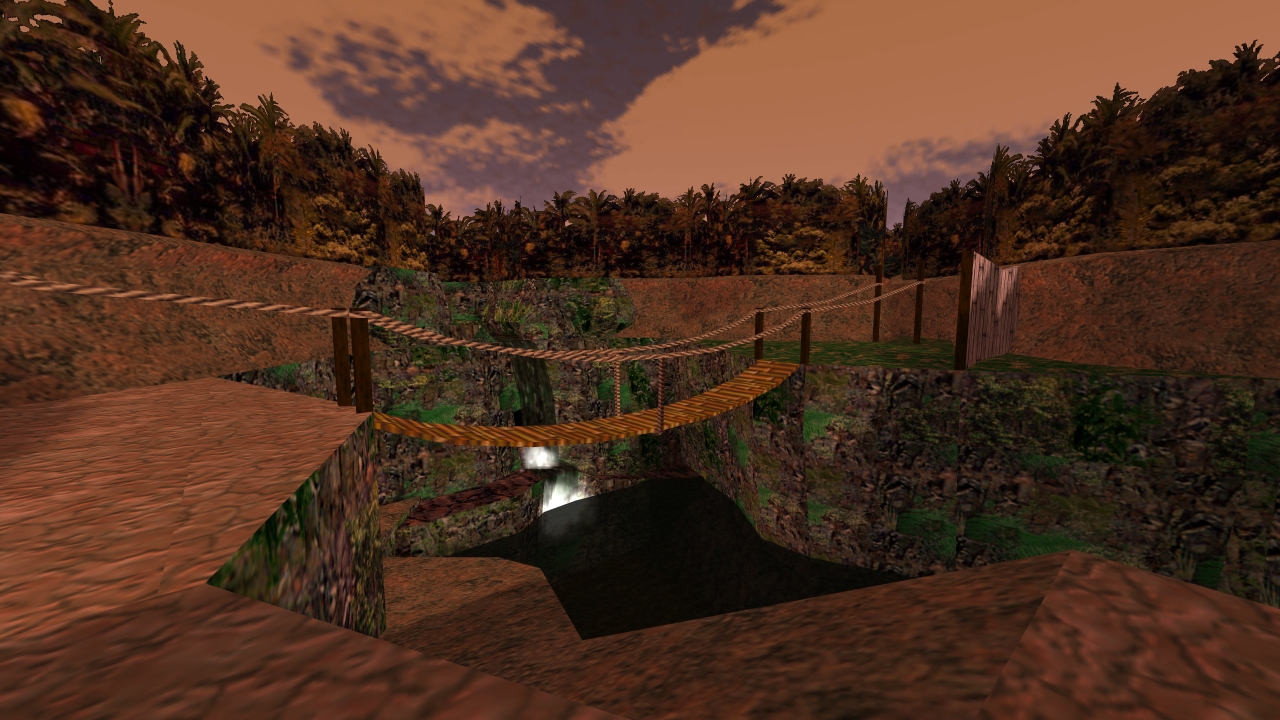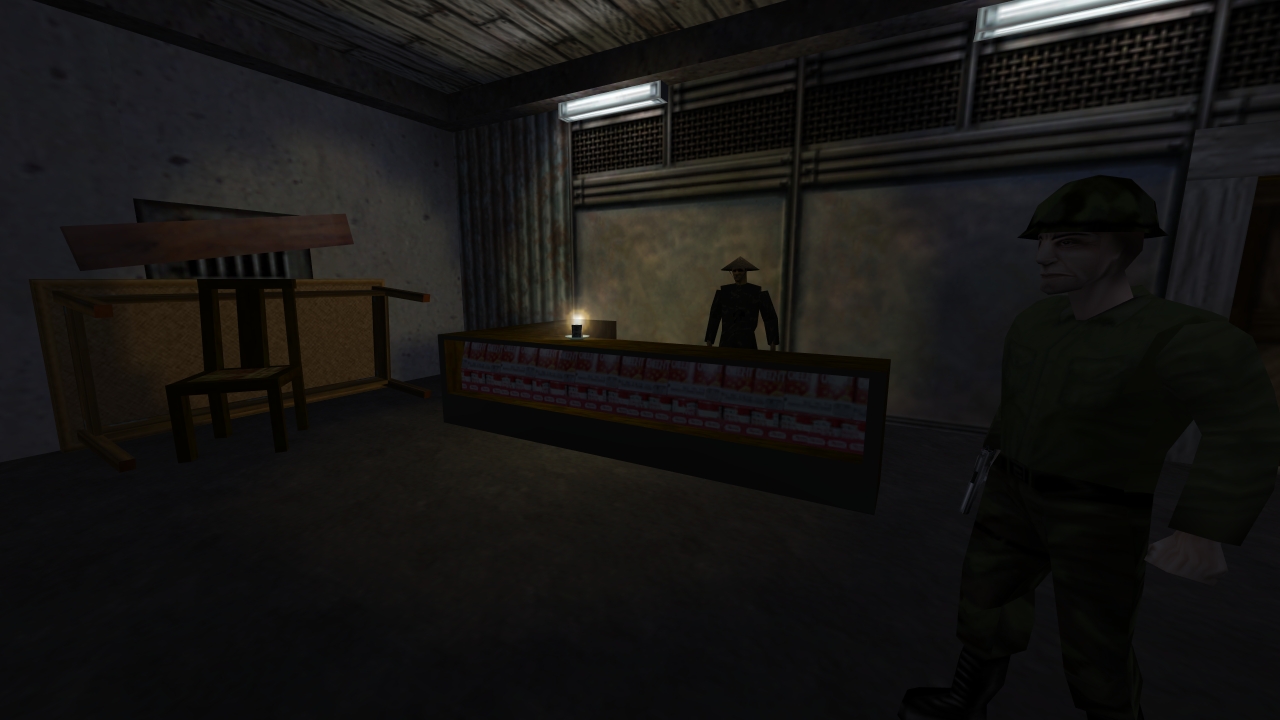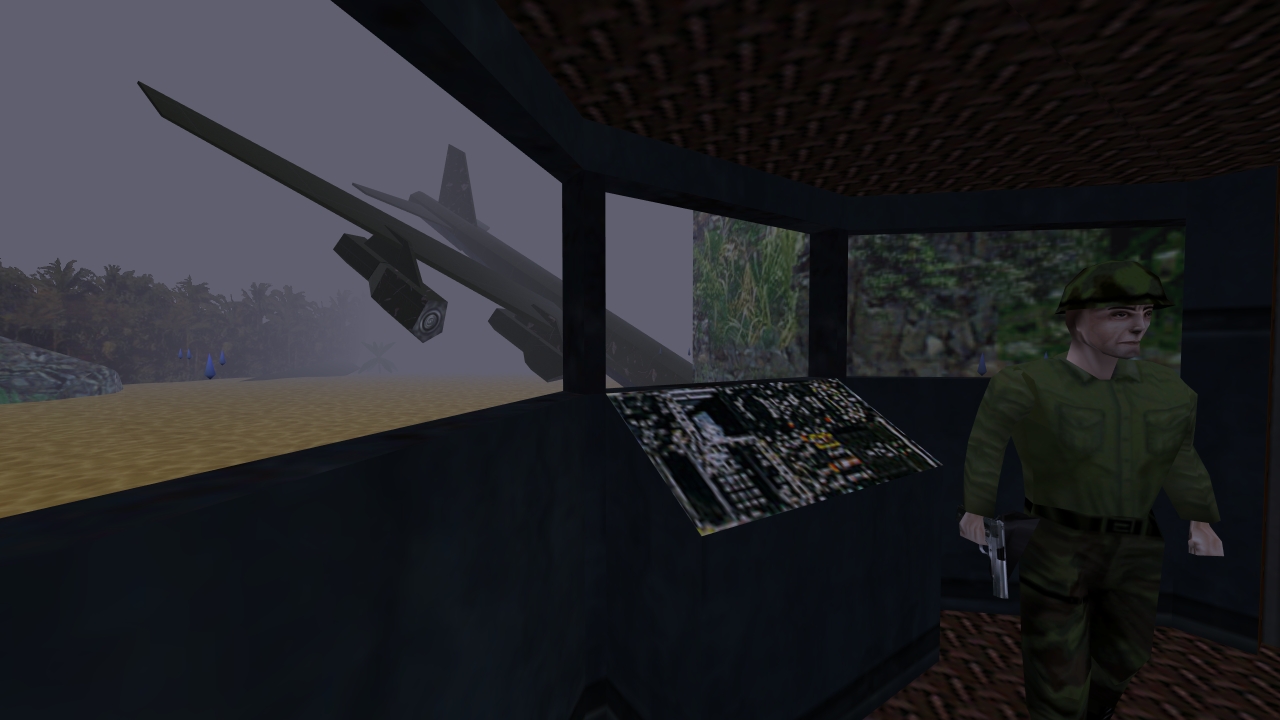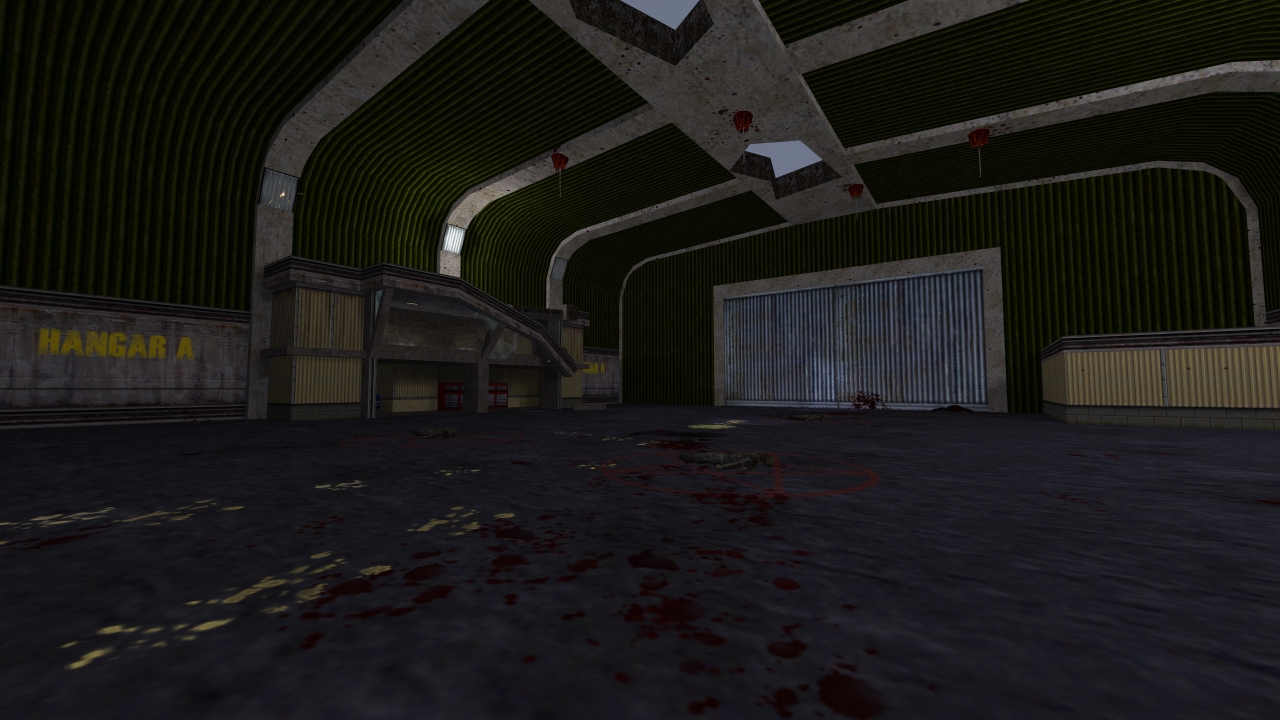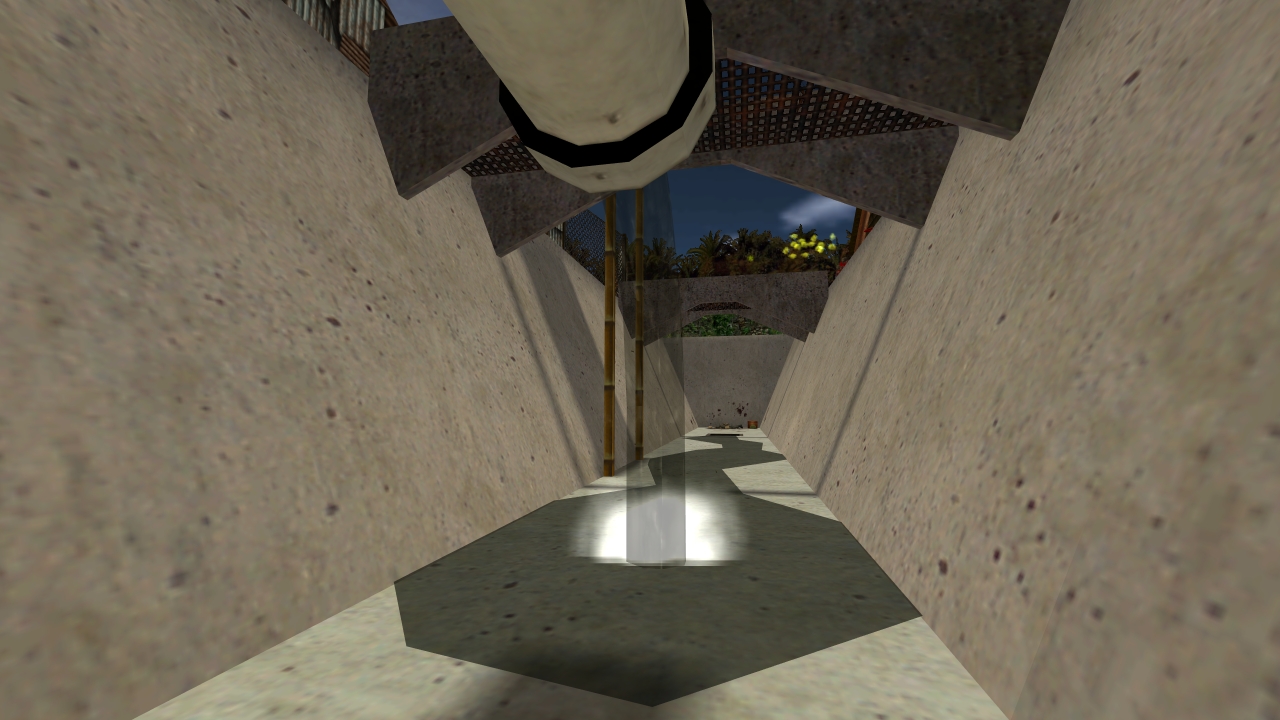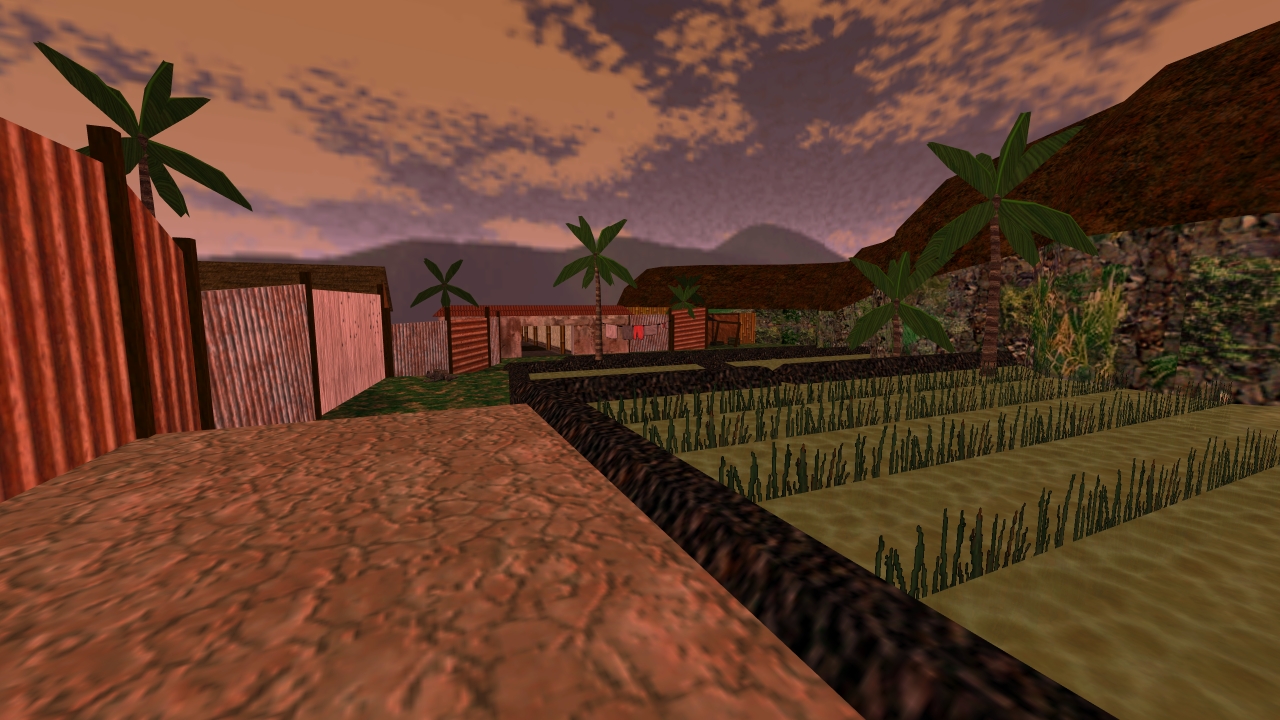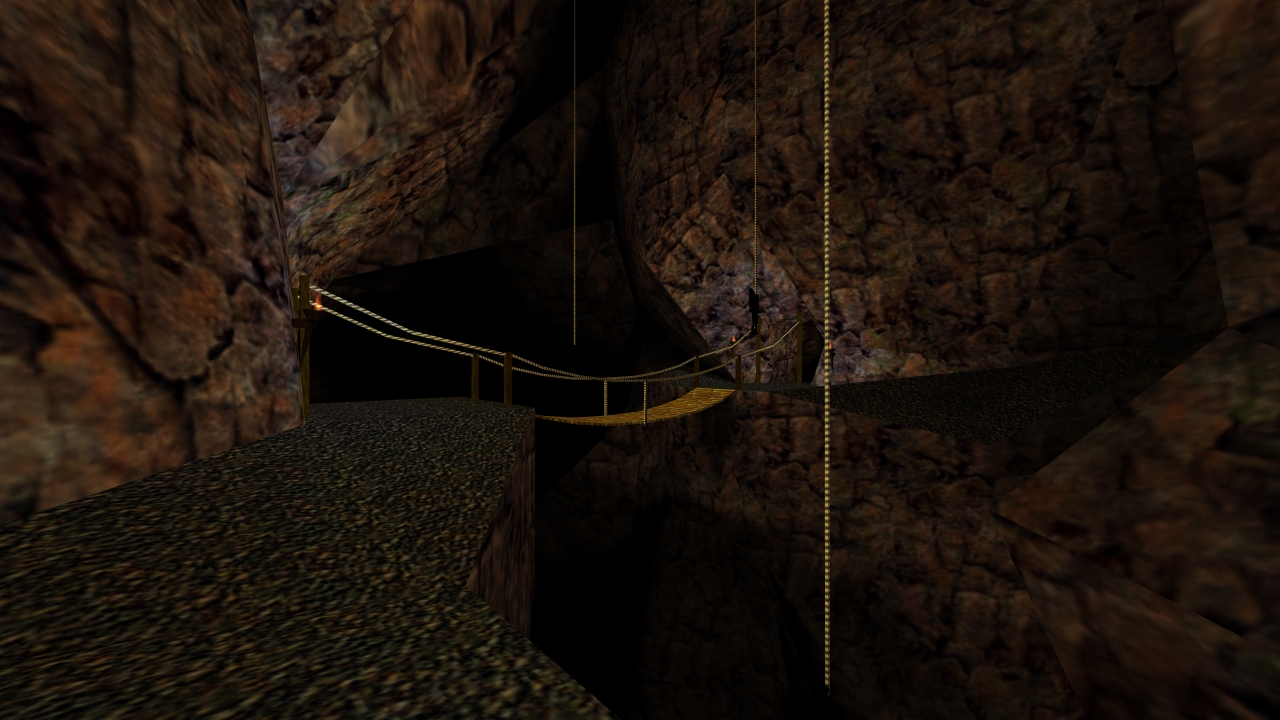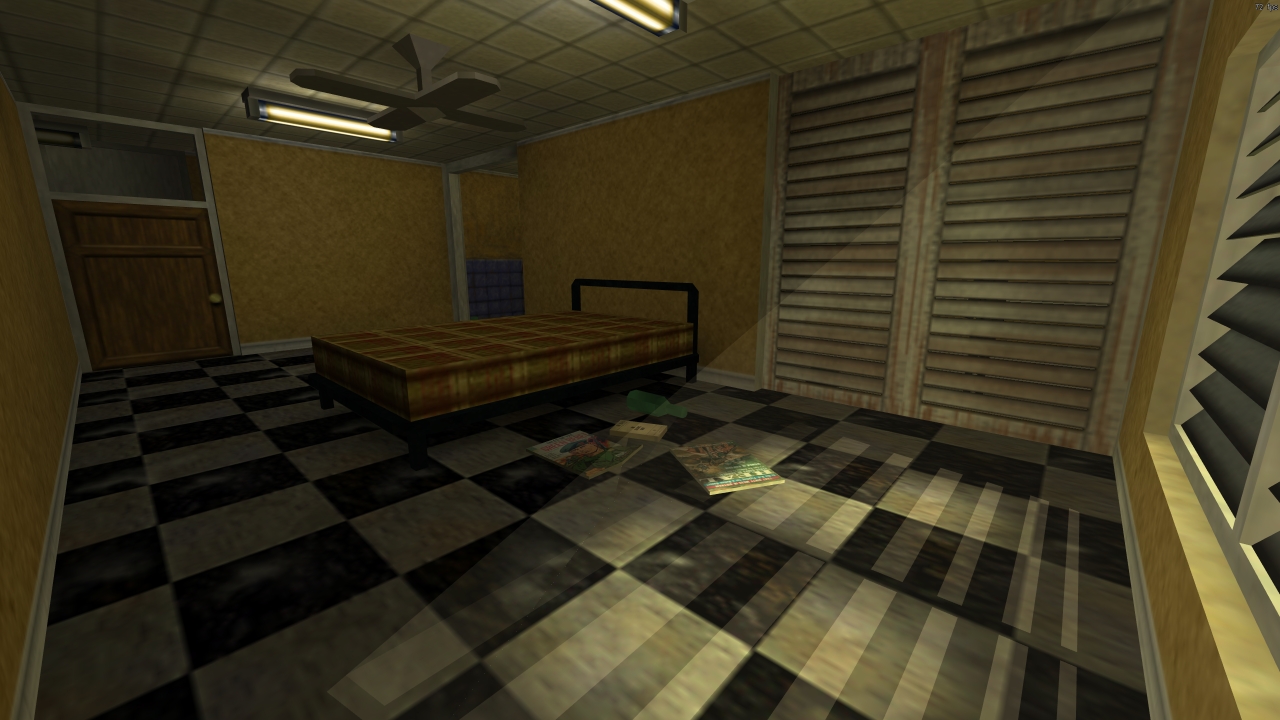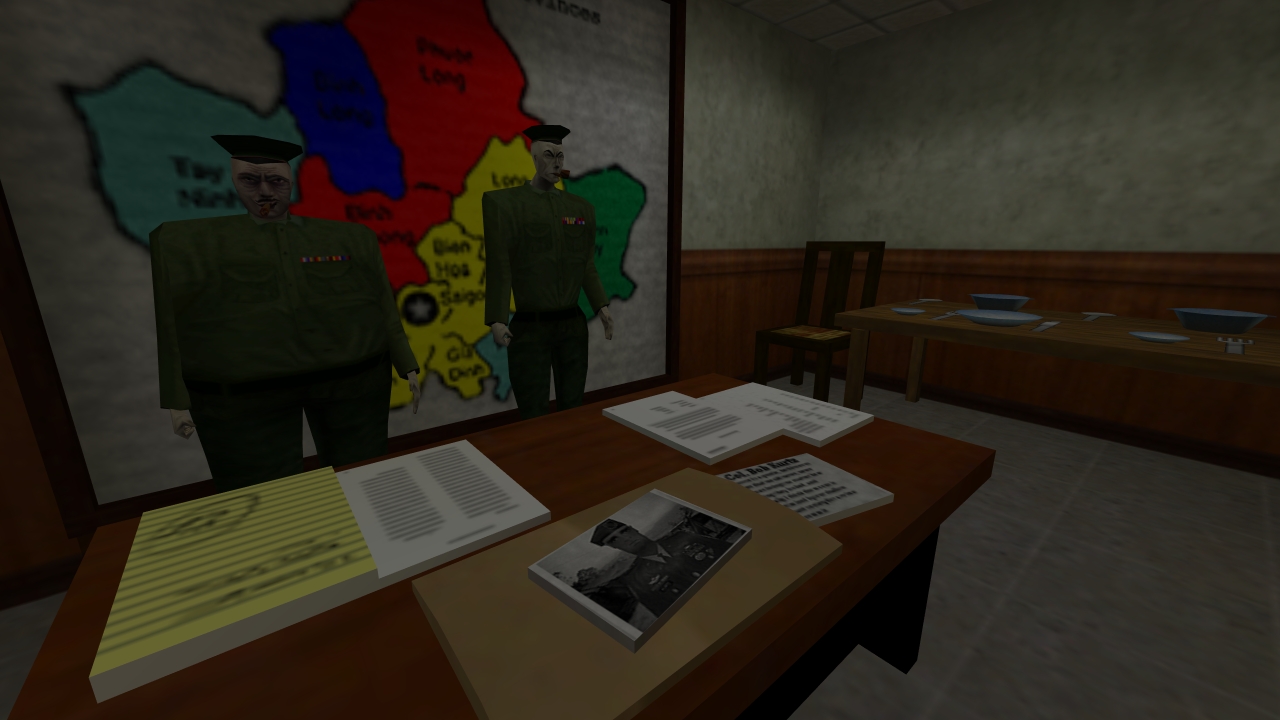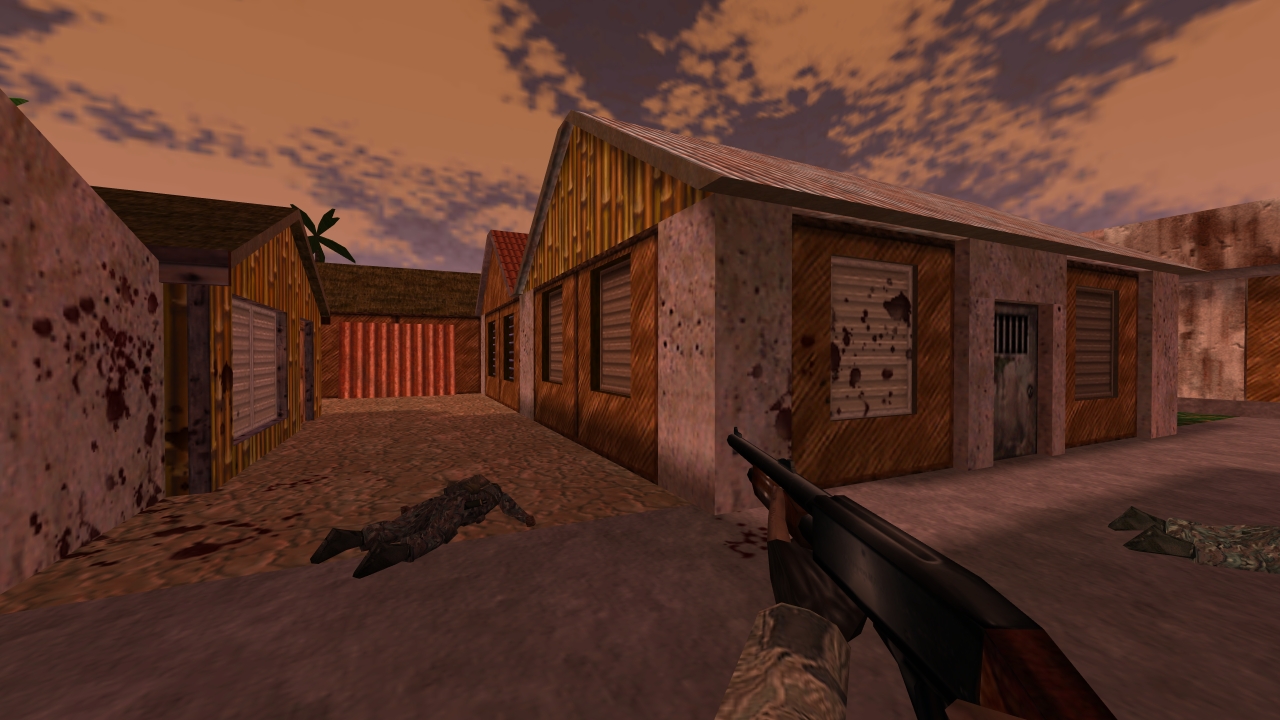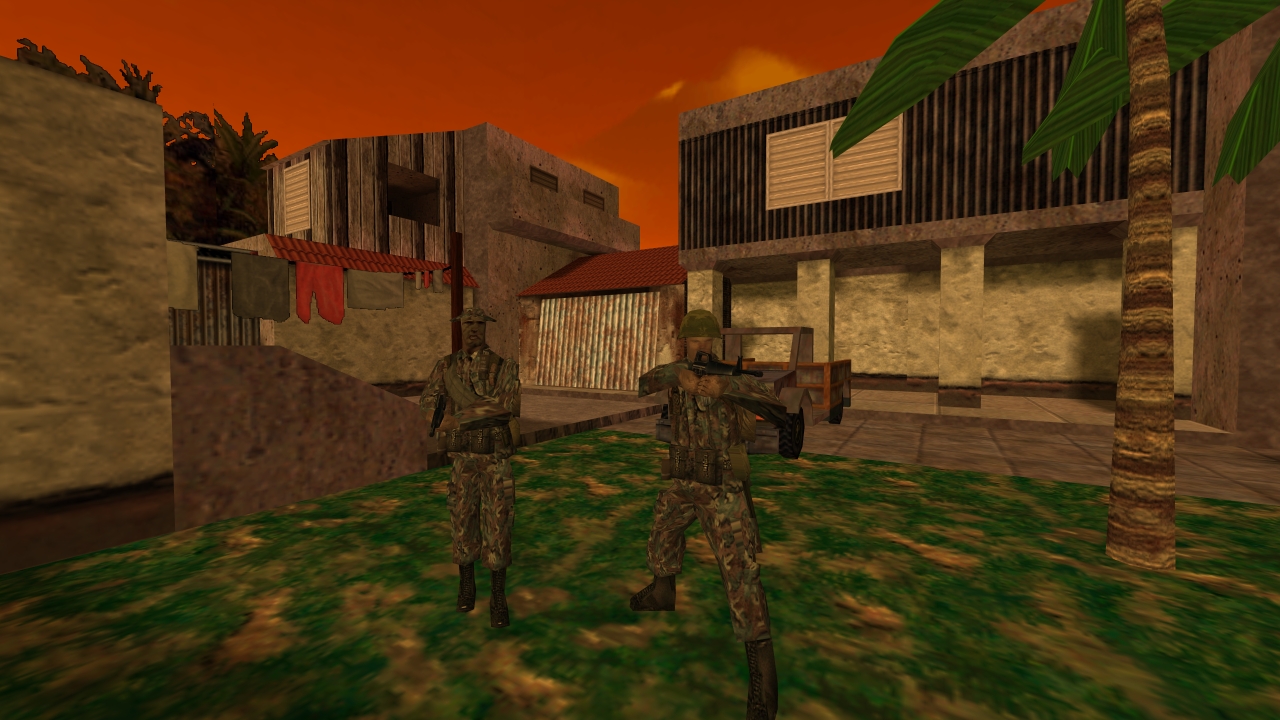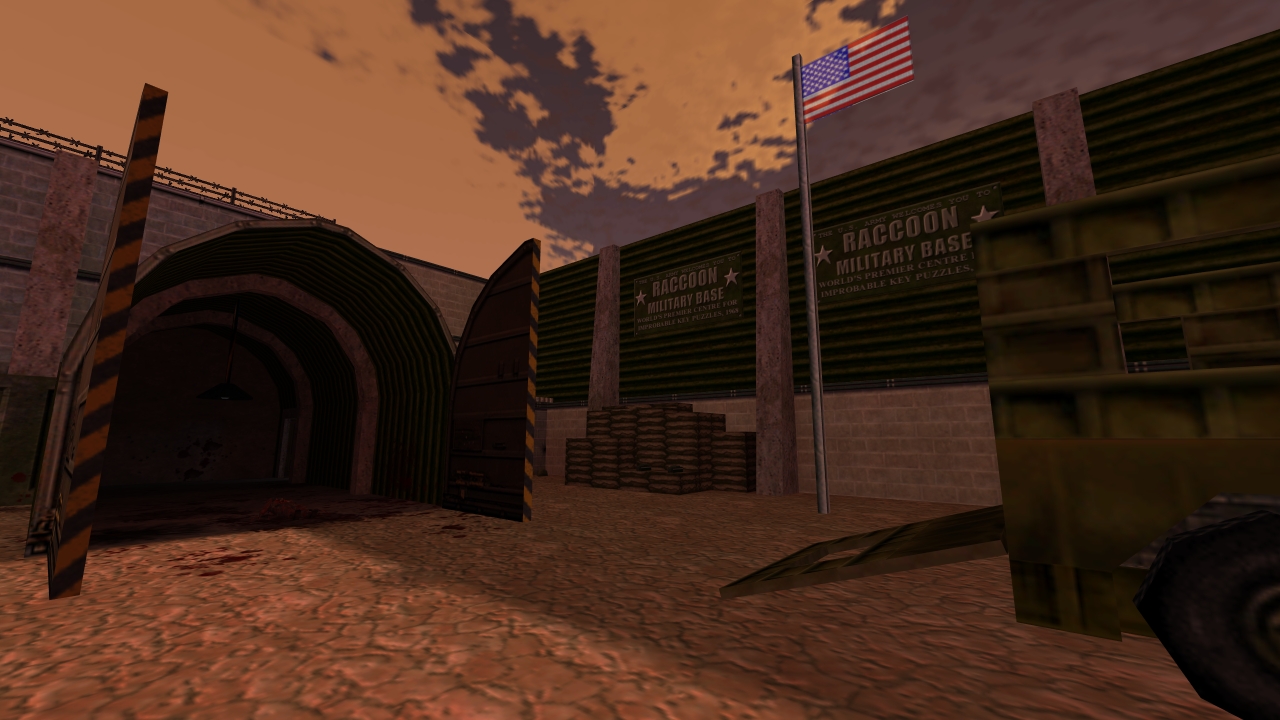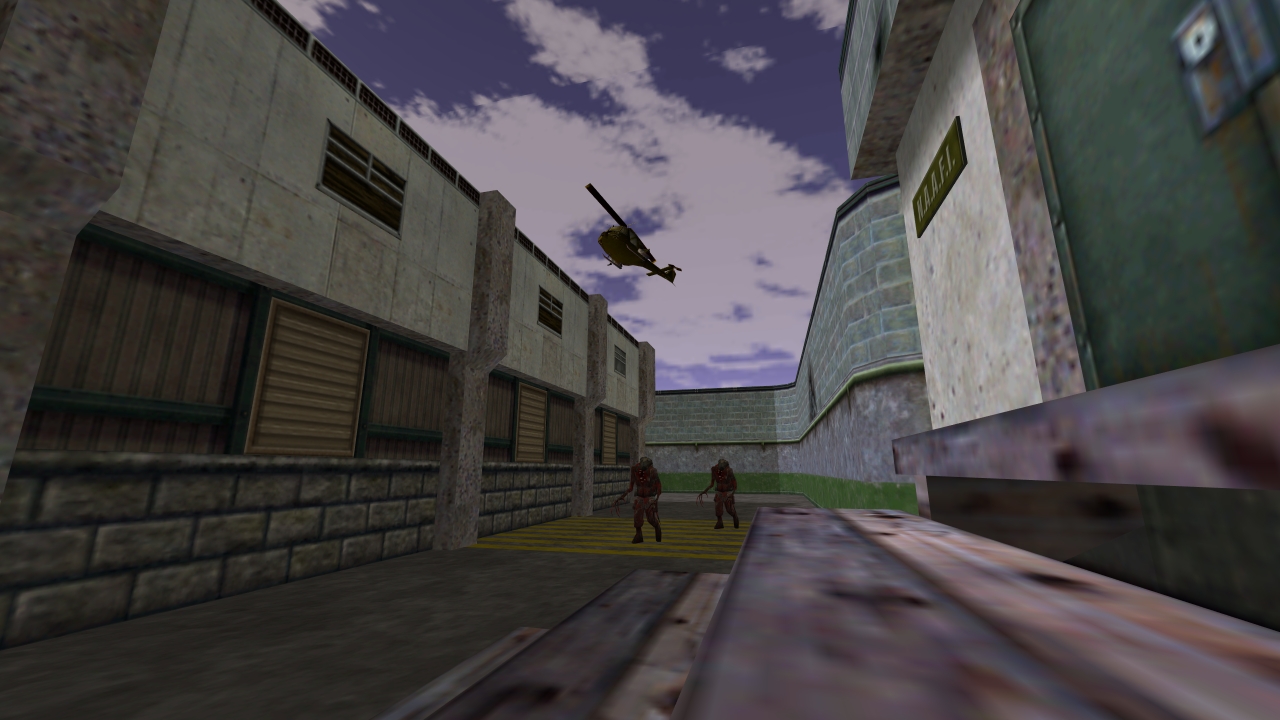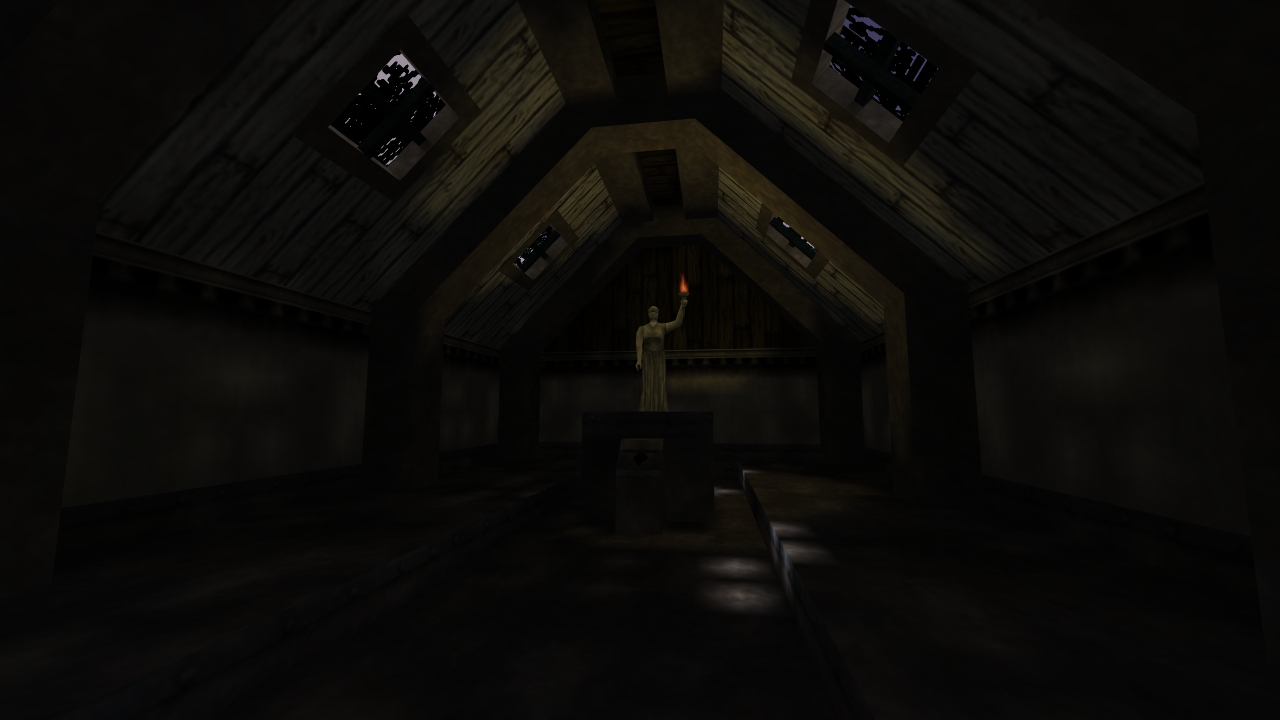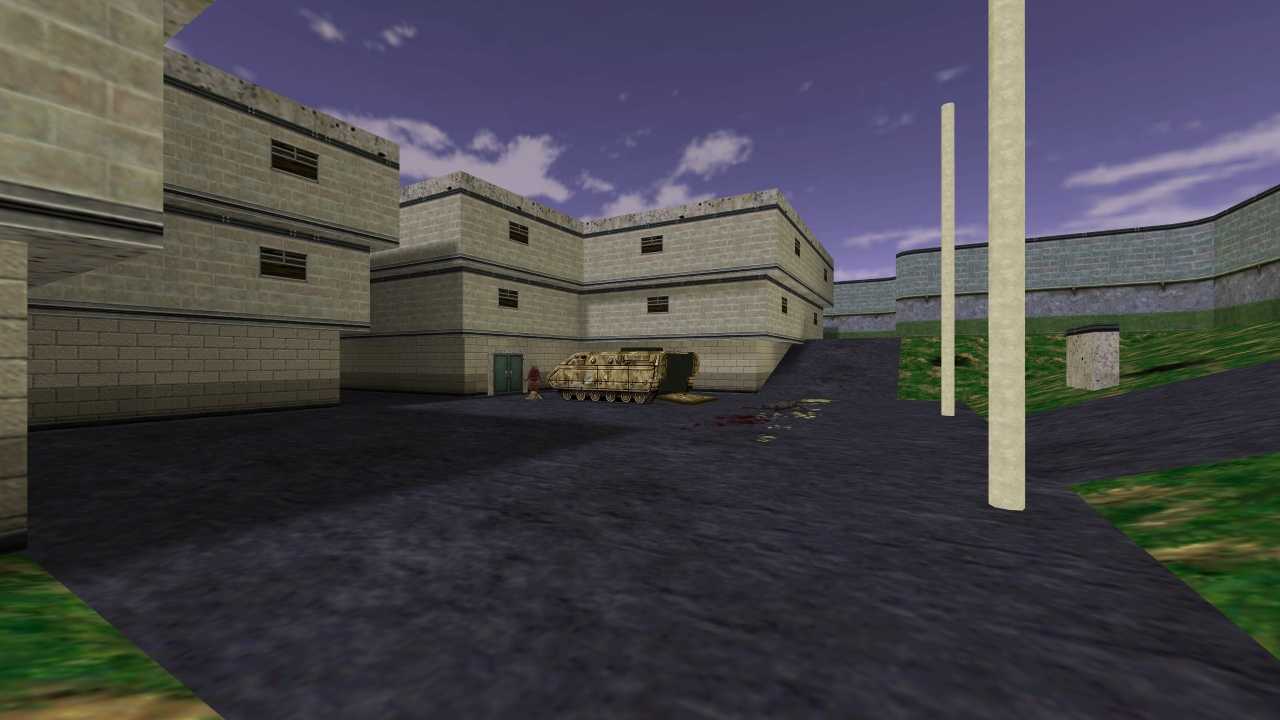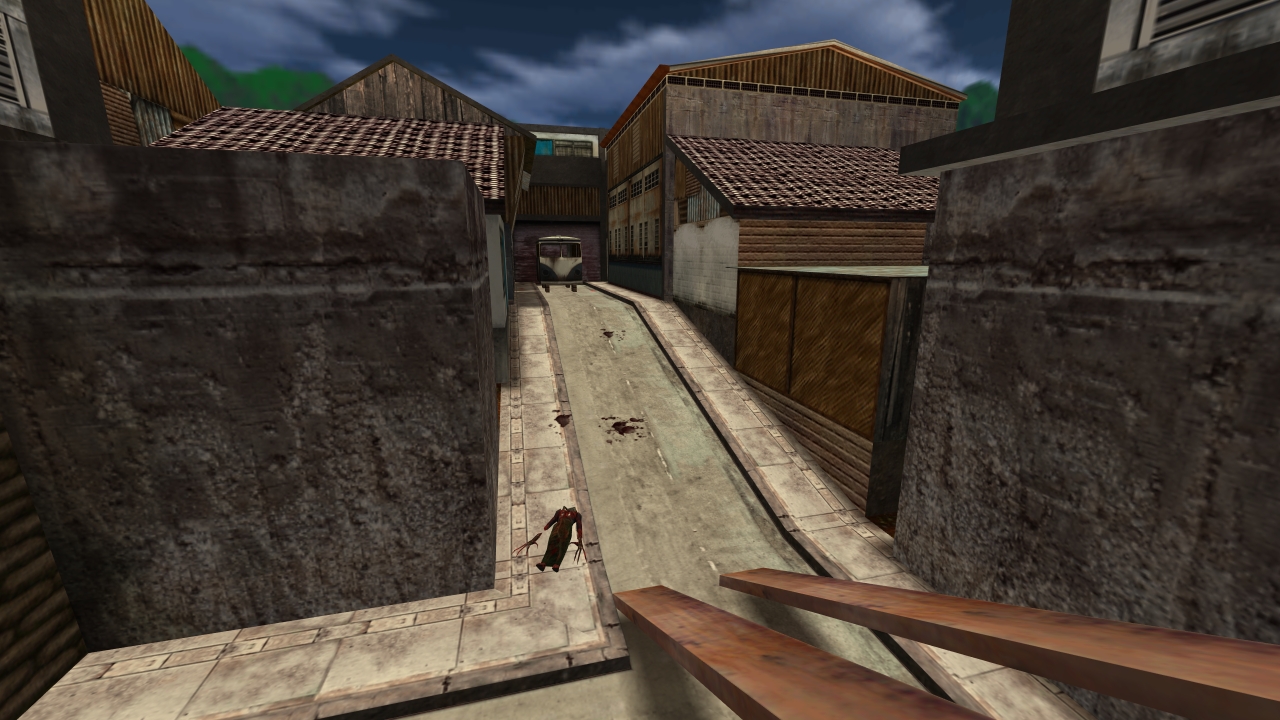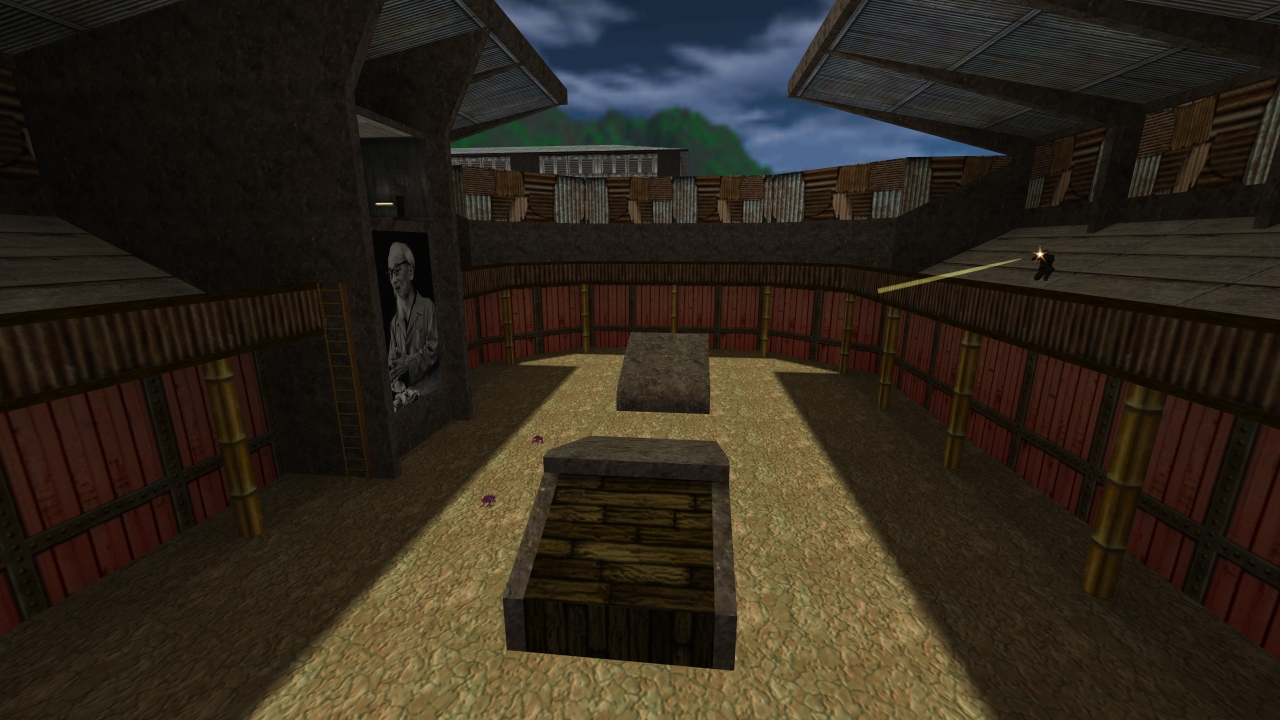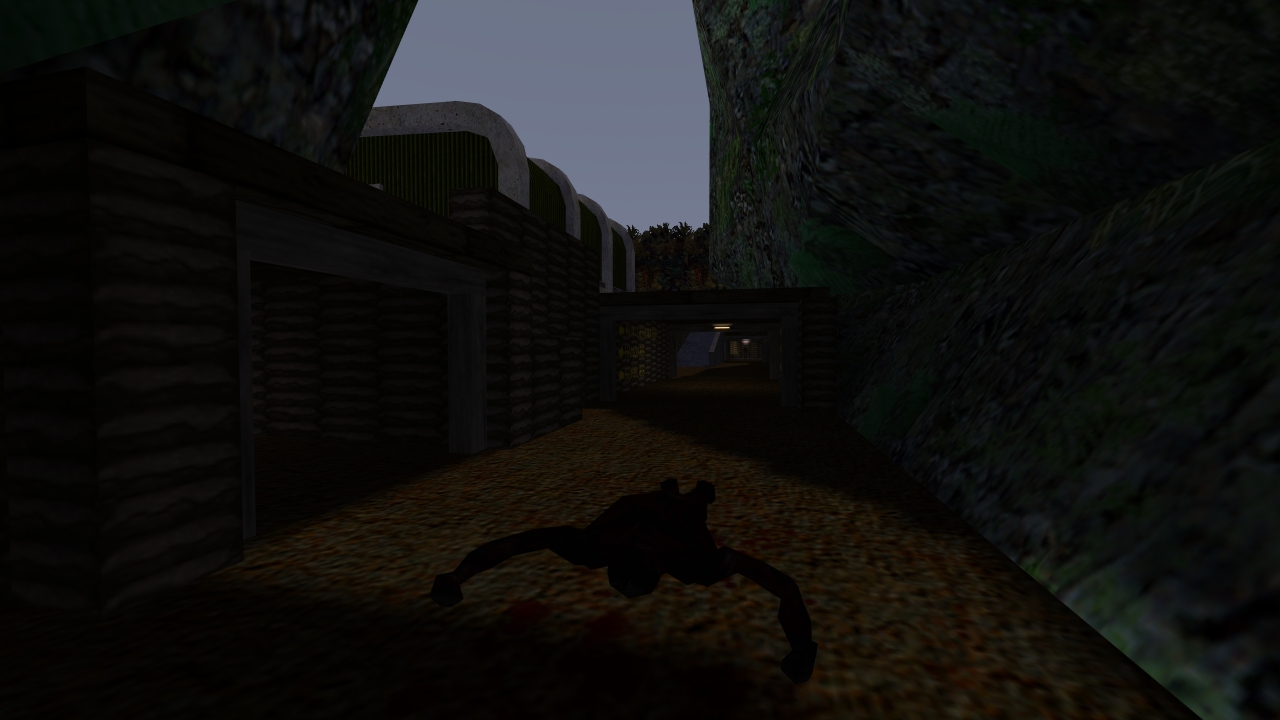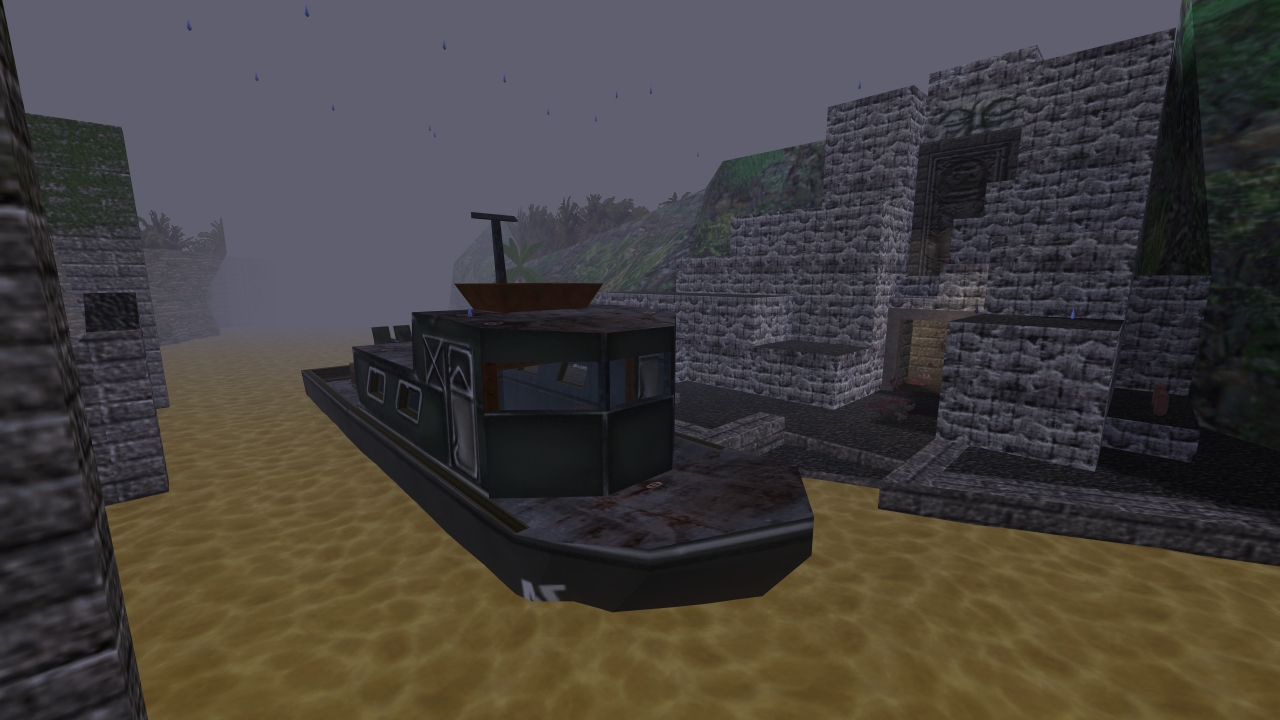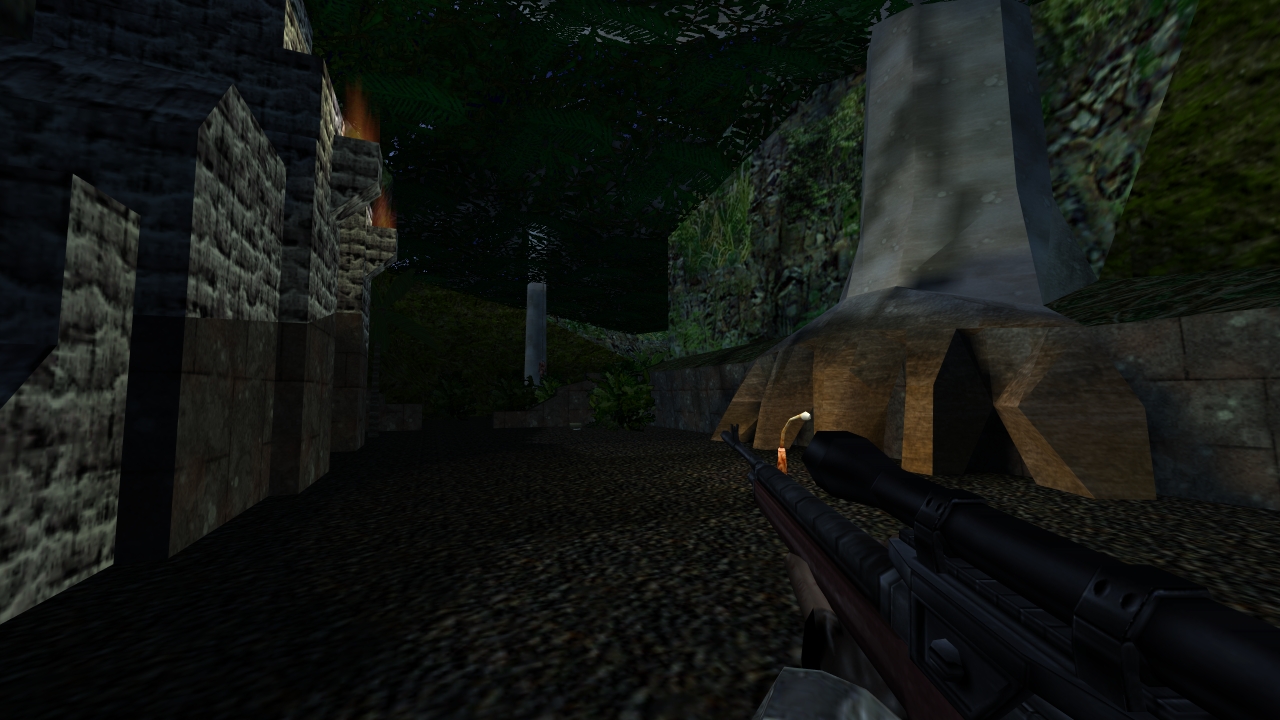Introduction
Special Forces officer Captain Percy Freeman has been partnered up with Barney to track down and assassinate the renegade Colonel Kurtz. The situation soon takes a turn for the worst when higher ups in the chain of command decide they want Freeman dead. To make matters worse, someone out there has been breeding an undead army of mutants who are rampaging across the jungle causing problems for everyone. Whether completing the mission may lead to answers, it will be a struggle for survival to discover an end to this madness.
Review
While I am aware of an overhauled Napalm Edition, I wanted to take another look at the original mod, a classic as I remember playing it for the first time many years ago. Taking place during the Vietnam war, the intentions here are much simpler despite its choice of time period. Heart of Evil does not exactly aim for an accurate depiction of reality nor makes any attempt at commentating on this part of our history. The project’s story and scope instead finds inspiration from sources like Apocalypse Now and Heart of Darkness, while finding time to parody the survival horror genre for good measure. There’s a glorified war movie perspective concerning its overall tone, taking on a more explosive and exaggerated patriotic bravado where US soldiers are the ones sent in to save the day. There’s a very silly overtone dangling over every little thing almost like self aware propaganda. Voice work involves these blatant racial stereotypes for both sides of the conflict, from the hardcore US soldiers acting as if they’re certified badasses, to Vietnamese folk either trying to swindle your coin or marry off their daughters. Barney is an oddball that says some of the silliest lines, yet his entire dialogue is spoken with a straight face without hamming up the delivery. Punchlines here are dry and can be lost within a serious tone only making it funnier upon realising what is being said. HOE is all light hearted fun just looking for a few dumb grins in response and nothing more.
Having played both They Hunger and Heart of Evil within close proximity, not only recently but even going way back to when I first discovered them, I cannot help but notice similarities between Manke’s and Ruck’s work beyond just a superficial glance. Of course horror lies at the foundation for both projects centred around an escalating zombie plague showcasing the macabre and violent nature of the situation, yet the whole picture is flavoured with awkward humour and tongue-in-cheek sensibilities. Relishing in an absurd half serious tone, players are put into scenarios that begs the question whether we should be laughing or feel horrified, wanting to poke fun from every angle despite everyone else going up against overwhelming odds. While “They Hunger” leaned into a pulpy horror mould referencing classic dark fantasy, “Heart of Evil” otherwise feels more akin to the first Evil Dead film where a dark undertone is always lingering and the comedy acts as a reprieve from stagnation. Both journeys also involve a long and twisting path that starts out wandering across rural and remote locales before finding a way back to civilisation, or at least what still remains of it. There’s an analogue feel to how everything operates too, a lack of easy communication with the outside world, stuck with basic equipment and having to trek the hard road with whatever limited supplies can be scrounged up.
Whereas They Hunger constantly pushed players forward along linear paths that looped back through previous sections and had a consistent progression style between levels, HOE is driven by always changing up how the experience plays from a chapter by chapter basis. Besides both campaigns ending with a battle involving helicopters, this is where their similarities begin to taper off. Opting not to repeat how earlier scenarios flowed along, Ruck keeps player engagement through sheer variety where at least one episode may either appeal or betray expectations. Segmented into six very distinct chapters, each one is dependant on the type of objectives at hand and flow along from point to point in a different manner to the prior. The third chapter for example is a much slower paced maze navigation, the fourth chapter offers a choice between two routes with their own consequences and scavenger hunt, the fifth chapter involves weaving between a chaotic fight between four factions at once trying to make ends meet. Episodes play to their own strengths but all have the problem with their mission critical items blending far too well into the environment and important paths hidden in dark corners. The locales both Freeman and Barney visit are just as widely varied, navigating from rural villages, crawling through damp trenches, sneaking through an old town, exploring military bases, to getting lost deep within dense jungles. There’s bound to be at least one chapter somewhere along the journey that will resonate with players.
I appreciate that this world doesn’t simply centre itself around Freeman’s entire existence despite him being an important figure for the narrative. These walking dead and other monstrosities are an external problem for either side of the conflict, attacking military allies and Vietcong alike without discrimination. It’s like being back at Black Mesa, except the chaos has been dialled up a notch by having more factions scrambling about the same playing field. There’s a dynamic shift during conflicts as their outcome may not always follow the same conclusion and kept me guessing who would survive. I could leave these groups to tear into each other and slip by to deal with the consequences later, or take advantage now using the extra hands to take down those annoying zombies quicker. Hanging back at the sidelines just to watch who wins never got old either, choosing which engagement is worth the hassle on the fly. This whole concept is on full display during the fifth chapter where the military forces are distracted holding down the fort after undead break through their defences. VC using this as opportunity slip through the cracks all while monsters are wrecking havoc for both sides. Freeman is thrown head first into this mosh pit attempting to link up with his allies, a frantic dash across the entire base from start to finish creating the most memorable section from all Heart of Evil has to offer.
Combat is defined by the type of opponents encountered and the majority of enemies feel good to engage in, nothing too out of the ordinary from their Half Life counterparts. Zombies, on the other hand, were not an enjoyable adversary to be fighting against period and I don’t mean from a narrative perspective either. Unless I had ammo to spare for an LMG or .45, as both slice through these large health pools, every other firearm is a complete joke to them. Shotguns were toys that shot corks out their barrels, automatics spat out toothpicks and somebody must have replaced all my explosives with wet fireworks. Melee is not worth the effort unless bashing your head against a brick wall sounds like fun. The other mutant types don’t suffer from this same issue and still allows all weapons to remain viable with situational uses when put up against them. I understand the intent well enough, grounding these zombies as an unstoppable force of nature that could easily overwhelm even the might of a military’s firearms. Bullets do nothing to them as they don’t feel pain. Everyone is in danger of being overwhelmed and running away might be a better alternative strategy. In practise though it does not feel good to play and misses the mark.
When it takes almost an entire loaded shotgun blasted point blank to a zombie’s head; or a full magazine and a half from assault rifles; or even four entire explosive rounds from a grenade launcher to win against just a single zombie type enemy, amongst dozens of them across the campaign, calling it a slog doesn’t emphasis enough of the tedium combat involves. Running away just wasn’t always a good option as that simply poses the risk to be surrounded or have them blocking up doorways. They’ll also become a distraction with Barney in tow, so it’s less hassle dealing with them sooner than later. As a result I saved all LMG and 4.5 ammo to only be used against Zombies, never wanting to part from these beautiful weapons under any circumstance. Their damage per second results in a downed enemy before a magazine or belt reload is needed, which alone makes them desirable firearm choices. Patience to press on in these engagements took some effort, it’s not even satisfying achieving a kill and rather than feel fear or be threatened, I just groan in defeat should avoiding them proves to be problematic later on. I’m uncertain what may have been a better alternative to ensure their significance in the narrative were aligned during gameplay, but some ideas that might have been preferential would be giving zombies less hit points alongside additional quirks such as higher enemy density or they could revive after some time or have some external re-spawn system in place that occasionally fill in missing ranks after time passes similar to They Hunger’s earliest portions.
From the very beginning of HOE right up until the end, Barney will be accompanying Freeman on his mission and is an integral asset to getting important tasks complete due to his technical training and raw strength, therefore must be protected while escorted across the campaign to make progress at key points. This all sounds much worse on paper than it ends up being in practise since he doesn’t need to be constantly tied by Freeman’s side either. It clicked for me when forced to take down an attack helicopter guarding the chapter’s end point. My initial assumption was to guide him across to reach the truck between its gun runs, but the guy just wouldn’t budge further than a few steps before rushing back indoors to hide. From my perspective it seemed like pathfinding was having a breakdown, but the answer to this problem was much simpler. He won’t go into danger until the chopper has been downed and upon discovering a method to do just that, he complied with my instructions without issue and we escaped by truck. From then on it became clear what I should be doing in subsequent chapters; Find a safe place for Barney to park his butt and then scout out what lies ahead without his backup and solve problems until I need his assistance.
After headbutting the first barrier wide open it’s down to luck whether Barney will follow through without causing problems and a massive warning sign early on that HOE might be a miserable experience. In situations when his pathfinding doesn’t work, it becomes a tedious back and forth to wiggle the guy through doors and that alone can ruin the experience for many if it especially breaks too often. Sometimes it just works fine, other times he’ll be guided along a path via scripted events, other moments he stop dead in his tracks next to doors or ascending climbing stairs. There’s no consistency. Without him at certain points, progression to the next major beats will simply be halted. Barney is not exactly the most useful in a fight anyhow, lacking proper firepower as enemies love to prioritise him, better to utilise any geared up military allies along the way instead. Once I’ve done everything possible in a section by checking every door, unlocking shortcuts and finding something that requires his assistance before progress can proceed, I’ll return while clearing a safe path and then guide him there. This guaranteed he doesn’t die and kept moving, avoiding an otherwise frustrating experience that escorting usually comes attached with.
This also exposes additional issues concerning zombies that are best taken down rather than being ignored because they’re situated along these said routes, all in an effort to avoid unnecessary distractions that might get Barney killed. Even though shortcuts open up a level and make escorting a simpler task, there’s still the extra effort required for an uneventful backtrack to wherever Barney is waiting and then making that second round trip across those same silent and empty hallways leading toward to his objective. It’s between that or having him tag along to get in my way. Neither offers great outcomes. An alternative system that faked the whole companion side of things might have made this less of a headache for the whole journey, such as how Barney occasionally operates in later episodes. He can bunker down doing something important while Freeman explores. Once a milestone is reached, Barney can appear running into the room to operate a device or automatically head to places in moments of safety, like his short cave walk in Episode B or returning to Freeman inside the hangers during Episode D so players can focus on the actual adventure at hand.
Individual Episode Reviews
Because every chapter does its own thing with different play styles and type of goals to achieve, while taking place around varied settings and their resulting ambiance, below is an individual breakdown of my experience for these chapters and will include spoilers as I delve deeper exploring what makes each one tick.
Episode a: Saigon… Still only in Saigon…
Before we head into the fire zone, HOE takes a moment to ease players with an introductory chapter. Freeman is woken up by someone knocking at his door, a messenger letting him know their superior officers await Freeman’s presence. He’s to receive a secret mission briefing, one of utmost importance and will not to be considered on official record. Barney is our first point of contact here, a companion players will become familiar with from start to finish providing transport and spouting whimsical remarks along the way. Freeman hops into the back of a truck and is transported through the bustling streets of Saigon watching as the people go about their day to day chores. On arrival at the Commander’s Office and after being offered a bite of Canadian Moose, the mission details are provided to Freeman, a plot hook taken straight out of “Apocalypse Now”; eliminate the renegade Colonel Kurtz and his squad with extreme prejudice. Right away it’s becoming obvious that more is brewing under the surface than meets the eye and only time will tell before the truth reveals itself. Barney then leads Freeman to a chopper that’ll take them both to their objective, but I couldn’t help but notice walking past a scene involving prisoners and a firing squad letting loose. There’s a tonal whiplash after just witnessing that and then hearing Sergeant Bob Kilgore suggesting we put on a little light music during our flight, even complete with an onboard turntable to interact with. If the introduction does anything it adjusts my expectations according to its dispositions for dry humour during the macabre.
Episode b: 0600 hrs the following day…
Opening into the second chapter with “Ride of the Valkyries” blaring out from chopper loud speakers, Freeman is flown down river through a valley toward his landing zone. Its from here on we bear sights on a two way battle between US troops and Vietcong, each determined to take the other out by any means possible, causing damage to the environment, destroying property and civilian bystanders can only loiter amidst the chaos. The bravado I eluded to previously is on full display with troops zip lining down like action heroes, to our helicopter own flying confidently squeezing through a cave waterfall to reach its destination. Freeman must now trek on foot trying not to get caught in the crossfire, as a Huey over head destroys an enemy occupied cabin, a squad breaches inside a nearby building, right before the chopper overhead is shot down by an enemy RPG, exploding into shrapnel. Players are thrown into a war and Ruck does a good job establishing that chaos to set the scene.
Episode B’s primarily focus is on teaching the ropes as to where HOE can differ from typical Half Life gameplay and gives ample time to understand how Barney is utilised. Simple search and retrieve goals became a prominent component for several chapters going forward. When faced with a problem the answer usually involves finding an item somewhere within the vicinity, whether looking out for a key left behind on a bench or grabbing some rope. I still felt the need to be thorough so nothing went amiss, as unwanted back tracking is never fun only to discover an object in question has blended so well into the scenery that I’ve happened to walk passed it a few times. For this chapter the hassle is minimal as there’s only a small area to cover, but as the levels expand this did pose some potential problems that did halt progress for the odd occasion. I do enjoy the payoff after having grabbed both items though as there’s a neat effect involving a vehicle pulling at the worn pillar, causing a gunner position to collapse, taking out the trouble maker and opening up a new path. Barney awaits up ahead, calling out to warn Freeman of a trap, one which can’t be avoided to push the narrative along. Now this didn’t bother me too much at first, accepting that Ruck probably wanted to keep it simple, until reaching Episode D when an alternative is not only possible but changes how that section plays going forward. Having an option to not fall into the trap and discover a different approach could have been an extra bonus, even if that just involved minor tweaks during the scripted event with different dialogue and outcome while slotting into the greater scope seamlessly. Not much would have to change across the board for that to work.
Freeman is betrayed by the US Marine Corps, someone higher up the chain wants us both dead to prevent Kurtz’s assassination. Barney is a lovable idiot here, the only reason they found out about the secret mission is because Kilgore threatened not to be his friend any more. The same idiot companion tagging along until the finish line. It’s too stupid not to chuckle at. Even after escaping and being blockaded by a jammed door, Barney’s reaction is to headbutt it open with successful results. Ruck’s humour here is going to be hit or miss, HOE lulls you into this false sense of normality, with hints of nonsense surrounded by a semblance of grim realism keeps the guessing game going. Even unintentional moments became funnier because of this, after I caused an accident after placing the flare on a locked gate, watching as an air dropped crate crashes through it and splattering the village with a fresh coating of Barney. That wasn’t intentional, I swear! This entire next section after breaking out of the cell works well at teaching players what Barney is capable of and how to lead him around. Starting with a combat scenario it becomes clear he’s not capable protecting himself causing a failure state should he die, understanding early that keeping him out of the way to avoid engaging in fights reduces any headaches. After several bumps along the road, too many close calls and getting used to these annoying quirks of his, the episode ends with him hot wiring a truck to leave.
Episode c: The world of survival horror
Arriving at Raccoon Base doesn’t present Freeman and Barney much fanfare. It’s silent and not a soul in sight. When the main doors do open up, our only welcoming party is a swarm of undead monstrosities. Former inhabitants from the complex itself. With a name like Raccoon Base, an introduction to zombies and a the chapter title itself, there’s a blatant nod towards Resident Evil here. The whole chapter takes great inspiration from those classic titles to formulate a similar gameplay flow, getting familiar with a location entwined like a spiders web. Players are practically left to explore a whole military facility, taking note of locked doors that require keys indicated by their precious metal and jewel themed etchings. There’s more simplistic fetching for said keys and these oddly named gemstones to unravel a chapter wide puzzle box using out of place contraptions, even old man Spencer himself would prance around in glee. Perhaps they contracted George Trevor for the base design? There’s even diaries and other written messages scattered around to read, providing a little insight to what happened here or contain information for puzzles. I didn’t like how the message system was utilised however. Some entries are long reads and if you’re too slow, they’ll fade away before finishing and being forced to watch the whole message fill up letter by letter just to read the last portions. If you otherwise read fast, then now there’s this block of text sitting on the screen for a good while.
The main focus for this Episode C involves navigating and searching all of these branches that connect from the main hub, keeping an eye out to grab integral gemstone pieces and seeking out solutions how to access locked sections not necessarily only by using keys, such as a plank of wood placed between windows. Turning on a fan to leap over to a rooftop to make additional jumps across the barracks was another distinct moment too. I enjoyed learning the base layout, how one section connects to another and creating new paths after unlocking a shortcut. Keys themselves don’t offer much depth though as they don’t usually open up whole new locations, behaving as shortcuts to previously explored sections, either found somewhere nearby or on the other side of said door. Had they been boarded up like other doors the same purpose would be served, but the novelty is still a cute gesture. Ironically I believe the base itself had enough potential to have a proper lock and key spiderweb system to work as well as its inspirations. If there’s anywhere I didn’t like, the file cabinet maze counts as it’s too long and dark with little else involved besides plodding along behind as a chum-toad leads Freeman through it at a snails pace. Not exactly the most engaging few minutes to spend doing. Should players accidentally crush it to death, they’re left with two options; reload a save or attempt exploring it blind and have a needlessly horrible time. I tried for the sake of curiosity, but soon gave up not knowing what I’m even supposed to be looking out for in the first place and could have easily ran right past the solution.
The survival side of the journey is otherwise more of a narrative focus, driven around the idea of tackling a two way enemy conflict using Raccoon Base’s interwoven network of halls to juggle between these engagements. Not only is Freeman up against zombies and monsters, there are human grunts still here attempting to regain control by cleaning up this mess, but even they have their backs against the wall. They aren’t the worst of it. Helicopters circle the area shooting down targets and stopping periodically to drop off reinforcements. Travel between areas using outdoor routes can be a dangerous venture until an RPG is obtained, not that I would mind considering my alternative was fighting zombies. This is also where a precious LMG can be sought after, a reward given for players being thorough and well worth it as a duct tape solution against the worst enemy type dragging down an experience I am otherwise enjoying up beyond those negatives. As such I’m grateful there are only two reasons to ever return to Barney and not being forced to drag him along the whole way as the second time would indicate a milestone attained or chapter closure coming soon. Getting back to where I left him was never an issue for me after understanding the overall layout without a map, following either signs or texture schemes. Yet due to its size, having an in-world map with labelled portions could have been useful in preventing players wandering around in circles and remains consistent with what the Resident Evil games offered. The ending to Episode C is a hilarious nod at the absurdity of collecting keys, gems and solving all these puzzles when the actual solution is much simpler to execute.
Episode d: Revolution of the dead
The fourth chapter’s beginning segment can change based on what choice is made after speaking to the friendly fellow residing here, a decision that’s not even prompted that a second route would be available here. Do you give up weapons and have a safe passage through town lead by an offering guide, or keep your stuff and go at it alone? Considering the opposition I’ve been up against, I didn’t want to take any chances and cause my future experience to feel any more of a slog than it already was, hoping for another way around this without handing anything over. I looked around for another exit and tried bashing down the barricade with no luck. I despised the idea giving up an arsenal I’d built up overtime. If combat against zombies wasn’t the way it has been, my approach here would have taken a different turn of events. With nothing else in mind and trusting Barney’s instincts, I made the guy eat a bullet just out of spite and annoyance pretty much expecting the usual failure state slapping your on the wrist when an important NPC dies during other Half Life content. Yet surprisingly my actions were recognised as a legit response to proceed, not being punished with a boring fade to black but instead a reaction from Barney and a change to how the scenario from here carries onward. I absolutely adore it when special attention is made for situations like this to open up golden opportunities, even should it run the risk that many players might miss out. It’s only a shame more diversions and choices weren’t scattered around to play more into the idea of having a companion, discussing what steps to take and putting that task into Freeman’s hands.
Both scenarios were considered well and play out accordingly; You either take a quiet walk with a guide, avoiding traps and ambushes only to end up walking into your own prison cell to rot away. So much for the easy path. Taking the riskier option involves a fighting off zombies and Vietcong to later discover Barney stuck behind bars instead. Birds of a feather I suppose. Keeping your gear is much too valuable against the odds, otherwise being forced into a new acquisition cycle for weapons which may not provide the satisfying firepower to press on. Relying on external support from Barney and another troop who tags along isn’t any more comforting either. Whether becoming the saviour or saved, the episode otherwise converges back to a single point once the team is back together. Beyond that Episode D becomes another item gathering quest much closer to a scavenger hunt across a town district, more free roaming than the restricted paths back in Racoon Base. There’s an old bus missing four wheels, conveniently parked above a small incline facing toward a wooden ramp. That right there is an excellent sneak peek for an incoming payoff to look forward towards. My only trouble here was figuring out what places I still had left over to explore once three of the four wheels were in place, as not all routes seemed to be well sign posted and Ruck seems to obscure important paths using darkness too often for my liking across the campaign.
Episode e: Outpost on the edge of darkness
As the sky turns dark, a storm envelopes the fifth chapter as our protagonists crash land just outside Buon Rau Bang Nui base where a four way conflict is brewing from within. Freeman is not treated as the central character of focus here with all these events unfolding, everyone else desperate to survive one more day. Fellow allies find themselves against overwhelming odds, one group in particular going as far to barricade Hanger B and bunkering down inside as a defensive measure. Some didn’t quite make it to this refuge and can be found lingering in places. Armies of undead and monsters have been taking control of essential areas, especially around Ordinance, while harassing other places with critters leaping into the trenches and zombies stumbling out from the jungle. Vietcong have since taken this as an opportunity to slip between the gaps of defences while the outpost in on the back foot, but soon find themselves trapped in this web as well. Marines aligned with Kurtz make life harder for everyone else by attempting to silence whoever is left standing. Helicopters make a return here to cover a wide area, remaining in motion to make shooting them down with unguided rockets a difficult task. Skirmishes can be found all over the place and any faction could be on the winning side and turning their attention back the other way.
Freeman will want to make contact with those allies hiding inside Hanger B, but doing so never seems as simple as knocking on their door. The steps required to gain access are hinted at via environmental ques and its only a matter of time before an idea struck for me on where that solution lies. Out of everything that HOE serves during its main course, this episode lands easily as my favourite of them all not only because of how open ended and free form the exploration feels to partake in, but I also appreciate how Ruck trusts the player to figure things out on their own based on contextual clues found during gameplay. Every area is linked up using a tunnel and trench system as these roads between major sections of the outpost, originally built as defensive measures now turned against the very people they served to help having been occupied by enemy forces. I spent a good portion of my time trying to map out the outpost, to figure out what given tools are available before plodding along to execute a plan of attack. It was immersive trying to stay alive and feeling good discovering another path I can venture down, but much like previous episodes there’s a lot of ground to cover and can always be easy to get lost, a raw experience that may frustrate those expecting clear goals with a bullet pointed checklist to work from. Signposting on walls does provide guidance around but as it turns out, sometimes the obvious route isn’t the proper way forward forcing a little out of the box thinking navigating around blockades. Even after finding access into Hanger B there’s still more work to be done reaching the boathouse to flesh out the entire base.
Episode f: Kurtz
The concluding episode is a bit of an oddball, like a soup made with conflicting flavours and textures, as its not one long coherent chapter like all those that came before it. There are these big jumping points leading from one scenario into another, going off course abruptly before heading back on track for the final showdown. We start with a drawn out boat ride down the river as a night fog rolls over, contemplating on what the journey has meant to Freeman so far and where he should consider concluding it. There’s an immediate tonal shift as pacing becomes linear, steadily pushing players forward with frequent changes to the environments that follow. This is evident right as the boat docks just outside an ancient ruin, which too bad for players doesn’t offer much for exploration given it’s a fresh take after trekking through villages, towns and two military bases. It’s a short sequence guarded well by undead as an entry point into dense jungles beyond, which do make up for slight blunder, containing some unique events and really neat sights to behold there. This area includes a new enemy type which Barney has the misfortune of running into, blending in and out of the jungle making traversal tense and dangerous as not to be caught off guard. Tracking their distinct sounds is one method to fight them, however I preferred dominance by staying above the canopy and just lobbing grenades down into the surrounding area until I no longer heard signs of movement. The lead up to rendezvous back with Barney is a great discovery that ultimately results in Freeman’s capture, scene ends and we’re moved elsewhere.
Slapped in the middle, right before hitting the finale, there’s a strange additional segment that provides premium access to Half Life 2 well before it’s official release date, available right here in Freeman’s cell on an arcade machine only found in Vietnam. I’m certain this only exists as a fourth wall breaking joke, not simply a nudge in the ribs either and it wouldn’t surprise me if these were scraps from another project pieced together to get some use out of them. It’s a jarring and weak inclusion as the finish line draws near. HL2 Arcade Edition repeats the general outlines taken from Half Life, taking a tram ride to a secret lab where aliens have overtaken the base. It’s a very basic corridor shooter up against these annoying lizard creatures, both small and large, that love to dart around and perform leaping attacks. There’s little actual meat on the bone here with nothing interesting going on with combat and progression forces some needless backtracking just to pad out the length; as an example there’s a tower than requires a key card to access its lower level, with control panels topside used to close air tight hatches during a vacuum breach. One of these chambers contain said key and if the hatch remains open, Freeman is sucked out into space. This requires an uneventful walk to snatch the item and then return. Nothing else of note happens the entire time. I wouldn’t have minded if this entire sequence had just been snipped out from HOE as it doesn’t belong here. Part of me thinks there’s a commentary about sequels being an empty shell trying to cash in on what made the original so special but missing the point. Another part of me believes I’m just looking too much into it trying to find something notable to relieve the boredom I had getting past this little detour.
Once HL2 Arcade Edition has been beaten, the following scenario takes a strange but not an unwelcome turn, hammering home an eerie strangeness taking place here. Kurtz is loitering around not at all concerned about Freeman escaping, only muttering to himself about “the horror”. Undead are just chilling out chomping down on human meat, corpses are left hanging like display pieces and Barney’s head can be carried around. The rest of him has been thrown in a separate cell. Continuing along these steps eventually leads to decapitating Kurtz, grabbing some firearms and preparing to face off against three incoming helicopters. I couldn’t quite understand the full intent going on here but my interpretation is that Freeman is simply proceeding with what Kurtz set out to do by his own hands and preventing the military from striking back. In the end, everything is destroyed as a result as zombies take over the world. If Freeman was only being used this whole time and might have fallen prey to assassination as well to keep quiet about these discoveries, everyone else may as well follow suit and perish. The ending almost feels defeatist, all is naught and all is lost. Unfortunately I haven’t watched either of the film inspirations so there may be something else to grasp from those that I’m missing the context for.
Conclusion
HOE may be considered a classic mod from the Half Life scene with potential to be an amazing experience, but is otherwise held back by some glaring flaws that take a front seat. The journey by itself remains engaging as each episode provided different goals for players to aim for and environments to rummage through. HOE at its core is about an army of zombies getting out of hand, who become a major opposition across the campaign, yet they are neither enjoyable adversaries or feel threatening. They were always a nuisance and plain boring to fight against. Avoiding them never seemed like a viable option worth attempting because of later consequences. Barney as a companion along for the ride is a good concept on paper but doesn’t quite deliver in execution when his pathfinding tends to break at the worst of times. If he’s parked up like a vehicle waiting for players to return then his presence is simply lacking and encourages a cycle of uneventful backtracking. HOE had a lot of potential to approach these concepts from a different angle while still retaining their meaning. Episode E highlights some of these strengths and a uniqueness that HOE can offer when applied together properly.
Download Mirrors
This is a re-review. The old review has been archived here.

